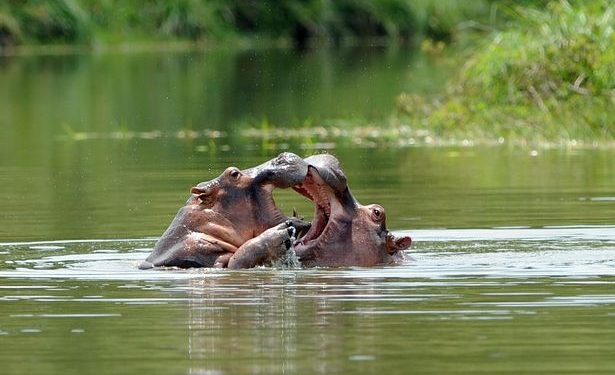Notorious drug lord Pablo Escobar left a bizarre legacy of cocaine hippos that continue to cause havoc in his former homeland 30 years on.
The Colombian crime boss built up a £24billion fortune in the 1980s and 1990s. He used some of his illicit gains to build an illegal private zoo full of exotic critters, including the potentially deadly African beasts.
But since he was shot dead aged 44 in 1993, the huge hippos have been left to roam the tropical wetlands around his former luxury estate and have thrived.
Some of the five-tonne animals have attacked people living locally and their multiplying numbers are threatening the region’s environment.
Last week, scientists renewed their calls to cull the animals before their numbers soar out of control.
Dubbed the King of Cocaine, his drug-trafficking career saw him become the seventh richest man in the world, while ruthlessly carrying out kidnappings, murders, and bombings.
But Escobar also had a soft spot for animals, illegally importing a host of creatures into Colombia, which he kept at his sprawling 5,500-acre Hacienda Napoles ranch.
The property boasted villas, six swimming pools, a hovercraft, private airport, race track, bullring, and entrance gate topped with the plane he’d used to make his first drugs shipment.
Yet Escobar’s ultimate pride and joy was his estate’s personal wildlife park stuffed with kangaroos, giraffes, elephants, antelope, ostriches, rhino, buffalo, camels and lions.
He had 700 workers to look after them and one had trained a flock of white birds to roost in the trees next to his mansion.
When Escobar was killed on a rooftop fleeing police, many of the animals were re-homed in Colombian zoos. However, some were kept on the estate, which has been turned into a public theme park.
But some of Escobar’s hippos escaped into the surrounding countryside. He originally brought four over from their native Africa in the 1980s, but since his demise, the animals, with no natural predators in the South American countryside, have been vigorously breeding in the lush habitat of lakes and waterways around the Magdalena river basin.
With some spotted hundreds of miles away from their original home, they now number up to 120 and boffins say that number could soar to 1,500 by 2035 without a controversial cull.
The hippos, which killed 500 people in Africa each year, left a farmer seriously injured last year. And in 2009, one nicknamed Pepe was killed by the authorities after attacking humans and killing cattle. There are also worries that they could edge out native species.



